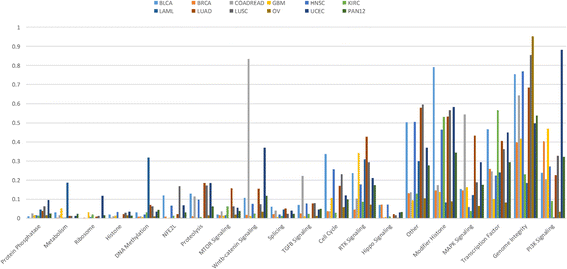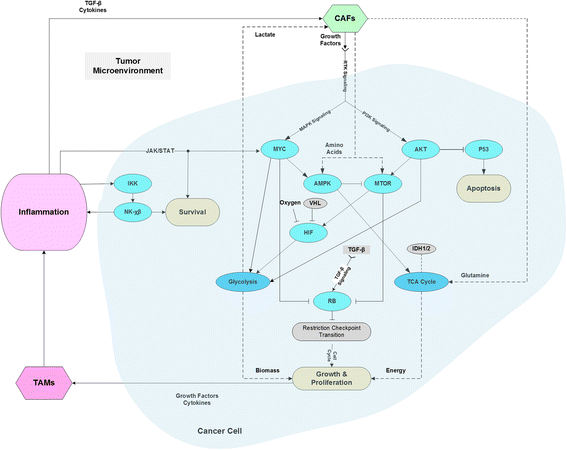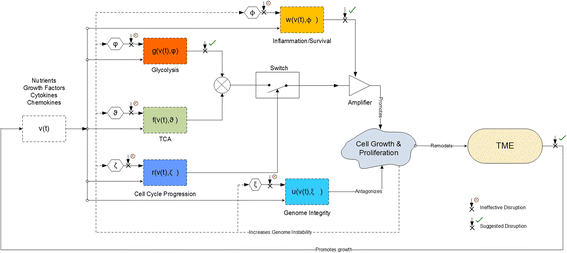Perspective on the dynamics of cancer
- PMID: 28969664
- PMCID: PMC5625776
- DOI: 10.1186/s12976-017-0066-5
Perspective on the dynamics of cancer
Abstract
Background: The genetic diversity of cancer and the dynamic interactions between heterogeneous tumor cells, the stroma and immune cells present daunting challenges to the development of effective cancer therapies. Although cancer biology is more understood than ever, this has not translated into therapies that overcome drug resistance, cancer recurrence and metastasis. The future development of effective therapies will require more understanding of the dynamics of homeostatic dysregulation that drives cancer growth and progression.
Results: Cancer dynamics are explored using a model involving genes mediating the regulatory interactions between the signaling and metabolic pathways. The exploration is informed by a proposed genetic dysregulation measure of cellular processes. The analysis of the interaction dynamics between cancer cells, cancer associated fibroblasts, and tumor associate macrophages suggests that the mutual dependence of these cells promotes cancer growth and proliferation. In particular, MTOR and AMPK are hypothesized to be concurrently activated in cancer cells by amino acids recycled from the stroma. This leads to a proliferative growth supported by an upregulated glycolysis and a tricarboxylic acid cycle driven by glutamine sourced from the stroma. In other words, while genetic aberrations ignite carcinogenesis and lead to the dysregulation of key cellular processes, it is postulated that the dysregulation of metabolism locks cancer cells in a state of mutual dependence with the tumor microenvironment and deepens the tumor's inflammation and immunosuppressive state which perpetuates as a result the growth and proliferation dynamics of cancer.
Conclusions: Cancer therapies should aim for a progressive disruption of the dynamics of interactions between cancer cells and the tumor microenvironment by targeting metabolic dysregulation and inflammation to partially restore tissue homeostasis and turn on the immune cancer kill switch. One potentially effective cancer therapeutic strategy is to induce the reduction of lactate and steer the tumor microenvironment to a state of reduced inflammation so as to enable an effective intervention of the immune system. The translation of this therapeutic approach into treatment regimens would however require more understanding of the adaptive complexity of cancer resulting from the interactions of cancer cells with the tumor microenvironment and the immune system.
Keywords: Cancer associated fibroblasts; Cancer dynamics; Cancer inflammation; Cardinal signaling pathways; Dysregulated cellular processes; Tumor associated macrophages; Tumor immunosuppression; Tumor microenvironment.
Conflict of interest statement
Ethics approval and consent to participate
Not applicable.
Consent for publication
Not applicable.
Competing interests
The author declares that he has no competing interests.
Publisher’s Note
Springer Nature remains neutral with regard to jurisdictional claims in published maps and institutional affiliations.
Figures






Similar articles
-
Molecular pathways: trafficking of metabolic resources in the tumor microenvironment.Clin Cancer Res. 2015 Feb 15;21(4):680-6. doi: 10.1158/1078-0432.CCR-14-2198. Clin Cancer Res. 2015. PMID: 25691772 Free PMC article. Review.
-
Tumor microenvironment and metabolic synergy in breast cancers: critical importance of mitochondrial fuels and function.Semin Oncol. 2014 Apr;41(2):195-216. doi: 10.1053/j.seminoncol.2014.03.002. Epub 2014 Mar 5. Semin Oncol. 2014. PMID: 24787293 Review.
-
Metabolic Interactions in the Tumor Microenvironment.Trends Cell Biol. 2017 Nov;27(11):863-875. doi: 10.1016/j.tcb.2017.06.003. Epub 2017 Jul 19. Trends Cell Biol. 2017. PMID: 28734735 Free PMC article. Review.
-
Metabolic reprogramming: the emerging concept and associated therapeutic strategies.J Exp Clin Cancer Res. 2015 Oct 6;34:111. doi: 10.1186/s13046-015-0221-y. J Exp Clin Cancer Res. 2015. PMID: 26445347 Free PMC article. Review.
-
Inflammatory fibroblasts in cancer.Arch Pharm Res. 2016 Aug;39(8):1021-31. doi: 10.1007/s12272-016-0787-8. Epub 2016 Jul 6. Arch Pharm Res. 2016. PMID: 27384063 Review.
Cited by
-
The Adaptive Complexity of Cancer.Biomed Res Int. 2018 Dec 5;2018:5837235. doi: 10.1155/2018/5837235. eCollection 2018. Biomed Res Int. 2018. PMID: 30627563 Free PMC article. Review.
-
An Introduction to the Mathematical Modeling in the Study of Cancer Systems Biology.Cancer Inform. 2018 Sep 12;17:1176935118799754. doi: 10.1177/1176935118799754. eCollection 2018. Cancer Inform. 2018. PMID: 30224860 Free PMC article. Review.
-
Deltex E3 ubiquitin ligase 3 inhibits colorectal cancer cell growth and regulates cell cycle progression via upregulating E2F transcription factor 1.Mol Biol Rep. 2022 Mar;49(3):1661-1668. doi: 10.1007/s11033-021-06916-7. Epub 2022 Jan 31. Mol Biol Rep. 2022. PMID: 35098394 Free PMC article.
-
Immuno-Oncology: Emerging Targets and Combination Therapies.Front Oncol. 2018 Aug 23;8:315. doi: 10.3389/fonc.2018.00315. eCollection 2018. Front Oncol. 2018. PMID: 30191140 Free PMC article. Review.
-
Contribution of Angiogenesis to Inflammation and Cancer.Front Oncol. 2019 Dec 12;9:1399. doi: 10.3389/fonc.2019.01399. eCollection 2019. Front Oncol. 2019. PMID: 31921656 Free PMC article. Review.
References
-
- American Cancer Society. Cancer Facts & Figures 2017. Atlanta: American Cancer Society; 2017.
Publication types
MeSH terms
LinkOut - more resources
Full Text Sources
Other Literature Sources
Miscellaneous

